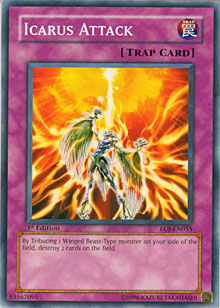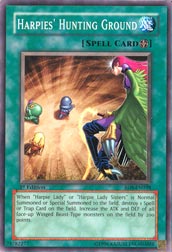Last week, I mentioned that there’s a bit of a question regarding which of the Force of the Breaker field spell searchers is the best. The choice was basically narrowed down to either Harpie Queen or Gravekeeper’s Commandant (though my vote belongs to Zeradias, Herald of Heaven, always and forever). Last week, I talked about the deck that Commandant turbo-charges. This week, I’ll take the opposite side and look at everything that makes Harpie Queen and the family of cards she serves deserving of the attention that they’re getting.
I suppose it started back in Enemy of Justice with the rather innocuous release of Icarus Attack. This common trap card was met with much praise as players touted it as “proper themed support,” yet no one ever touched the card. As good as Icarus Attack was, it wasn’t enough to propel Harpies—or Winged Beasts in general—to any sort of success. The deck was still lacking a win condition, which later came in the form of Hysteric Party from the Lord of the Storm Structure Deck. Party gave Harpies the ability to make a series of attacks and then, if the attacks failed or the opponent used mass removal, Party would return all the Harpies to the field for another go. It’s almost like a precursor to Crystal Beast Ruby Carbuncle if you think about it. In the same way that Crystal Beasts absorb all the opposing monster removal and then go to the spell and trap zone where Carbuncle can fetch them out, the same thing happens with Harpies in the graveyard waiting to be fetched by Hysteric Party. The problem here was that the way all the current Harpie Lady cards were written, you could only ever have exactly three of them in your deck at a time. Cyber Harpie Lady, Harpie Lady 1, Harpie Lady 2, and Harpie Lady 3 all counted as the same card for deckbuilding purposes. Therefore, the biggest swarm you could ever get out of Party was three monsters! At the very least, that’s not what I had in mind when I thought of a Harpie swarm, and that’s one of the main reasons I’m very happy about Harpie Queen.
Harpie Queen eliminates the deckbuilding obstacle that would-be Harpie players have faced for years now, as she only counts as Harpie Lady in the places where you’d like her to count: the field and the graveyard. Well, actually, you might want her to count in deck for the purposes of Birdface, but I think the tradeoff of actually being able to fill the field with Harpies is totally worth it. Even better is the fact that using Harpie Queen’s primary effect of fetching out Harpies’ Hunting Ground sets you up to then revive the Queen with Hysteric Party, all while claiming the effect of Hunting Ground in the process. Icarus Attack fuels this process as well, while clearing the road for your monsters to attack. When you put everything together, you might end up with something like this:
Monsters: 20
3 Harpie Queen
 3 Harpie Lady 1
3 Harpie Lady 1
3 Flying Kamakiri #1
2 Barrier Statue of the Stormwinds
3 Raiza the Storm Monarch
2 Cyber Dragon
3 Winged Sage Falcos
1 Sangan
Spells: 8
2 Harpies’ Hunting Ground
1 Heavy Storm
1 Snatch Steal
1 Mystical Space Typhoon
3 Smashing Ground
Traps: 12
3 Icarus Attack
3 Hysteric Party
3 Final Attack Orders
1 Mirror Force
1 Torrential Tribute
1 Ring of Destruction
I have a sneaking suspicion that the above deck is not at all what most people expected it to be. The reason for this is that, since Shonen Jump Championship Minneapolis, more and more people are playing their own versions of the Destiny Hero beatdown deck that brought Theerasak Poonsombat two more Day 2 finishes and gave Shane Scurry a win. The deck is filled almost entirely with monsters that have little to no ATK, which the player hides behind until he or she draws into whatever bizarre OTK combination will win the game at that moment. Numerous times throughout the event, we saw games won just because the opponent couldn’t get through 100 more points of damage, a malady that should hopefully never befall this deck thanks to Final Attack Orders. The fact is, all the Monarch decks and Destiny Hero-based decks that have been succeeding lately do so thanks to their remarkable ability to stall out the game behind a constant wall of monsters that you just don’t want to attack.
No one wants to put Disk Commander in the graveyard, no one wants to slam into Gravekeeper’s Spy and watch the opponent fetch another, and Card Trooper is enough to give any player fits regardless of what position it’s in. All of these monsters—and Destiny Hero - Malicious too—are simply tough to deal with. I would argue, however, that when dealing with monsters like this, waiting around for an answer that will likely never come while your opponent draws cards and gathers everything he or she needs to win is a bad plan. I would also note the lack of hard removal options in these Destiny Hero decks. Sure, they’ve got Mirror Force, Ring of Destruction, and Torrential Tribute, but they aren’t playing any copies of Sakuretsu Armor or Widespread Ruin. In fact, those three traps are the only reliable, reactive removal the entire deck packs, so why not become the aggressor and stamp your opponent into the ground before he or she can draw into a win? That’s what Final Attack Orders is all about, and with the swarm and removal abilities that Harpies and Winged Beasts in general have access to, it becomes more and more likely that your attacks will hit home.
 The next thing to address is how you should use Harpies’ Hunting Ground. You wouldn’t believe how many people just throw down a field card before it has any relevance to the game. Doing so opens your field card up to removal. Holding it in your hand until necessary can draw that removal toward your other spell or trap cards. Specifically, I would bet that people will go after Final Attack Orders, which, in the long run, is all right as long as you get plenty of damage out of it beforehand. The key to using Hunting Ground successfully is to treat it as if it’s an extra Mystical Space Typhoon and only drop it when you’re about to summon a Harpie. By using it this way you keep the field card out of harm’s way for as long as possible while gaining the exact same benefits you would have reaped had you left the card sitting, waiting to be destroyed. With Hunting Ground, Harpie Lady 1 pumps all the way up to 1800 and the presence of both gives all your other Harpies a grand total of +500 ATK once you factor in all the bonuses. Queen pumps up to Cyber Dragon level with help from the Hunting Ground, and both are able to take out a spell or trap card upon summon thanks to the handy field spell. The downside is that you must destroy a spell or trap whenever you normal or special summon a Harpie Lady, so make sure that you don’t inadvertently cause yourself to lose that field card, as it’s quite important and you only have two.
The next thing to address is how you should use Harpies’ Hunting Ground. You wouldn’t believe how many people just throw down a field card before it has any relevance to the game. Doing so opens your field card up to removal. Holding it in your hand until necessary can draw that removal toward your other spell or trap cards. Specifically, I would bet that people will go after Final Attack Orders, which, in the long run, is all right as long as you get plenty of damage out of it beforehand. The key to using Hunting Ground successfully is to treat it as if it’s an extra Mystical Space Typhoon and only drop it when you’re about to summon a Harpie. By using it this way you keep the field card out of harm’s way for as long as possible while gaining the exact same benefits you would have reaped had you left the card sitting, waiting to be destroyed. With Hunting Ground, Harpie Lady 1 pumps all the way up to 1800 and the presence of both gives all your other Harpies a grand total of +500 ATK once you factor in all the bonuses. Queen pumps up to Cyber Dragon level with help from the Hunting Ground, and both are able to take out a spell or trap card upon summon thanks to the handy field spell. The downside is that you must destroy a spell or trap whenever you normal or special summon a Harpie Lady, so make sure that you don’t inadvertently cause yourself to lose that field card, as it’s quite important and you only have two.
As an additional bonus, Harpies’ Hunting Ground isn’t just useful for Harpies. A common misconception is that it only pumps up the ATK of Harpies, but in reality, it pumps up any and all Winged Beasts. This is great news for the deck, since it’s comprised primarily of Winged Beasts. Even Raiza the Storm Monarch and the Barrier Statue are Winged Beasts, so your Monarchs will have a 200 point edge over opposing non-Raiza Monarchs and Jinzo, while Winged Sage Falcos will become a 1900 ATK monster that can return any attack-position monster it destroys in battle to the top of the opponent’s deck. Imagine hitting Disk Commander or Malicious with Winged Sage Falcos. It’s enough to make a Destiny Hero beatdown player cry as he or she is forced to redraw a copy of Destiny Hero - Malicious without ever having the opportunity to put another copy of him back into play for free. Falcos is incredibly nasty, and while its interactions with Card Trooper leave much to be desired, its ability to break the opponent’s defenses open and then keep them open is something to be admired.
If I were to describe the manner in which this deck is meant to be played in a single word, it would be “aggressive.” You should be looking to destroy monsters in battle whenever possible, and snipe opposing spell or trap cards with Hunting Ground whenever applicable. Meanwhile, anything that you can’t destroy outright becomes vulnerable to Icarus Attack (except Jinzo and Ryu Senshi) while you hopefully fill your graveyard with Harpies for use with Hysteric Party later in the game. Remember, your opponent’s field doesn’t have to be bare in order to win with a Hysteric Party swarm. Hunting Ground and Final Attack Orders will do a lot of the work for you, especially in the face of tough defense-position monsters like Spirit Reaper or Gravekeeper’s Spy. Attacking quickly and repeatedly is the key to victory over the top decks from Minneapolis, so if you have someone at your local shop who thinks he’s Clever Dan because he has all the cards to make Shane Scurry’s deck (sans Crush Card), feel free to give him a piece of your mind in the form of a nasty Harpie swarm tearing through his puny monsters. At the very least, everyone else in the store will thank you.
School of Duel is delayed due to my need to finish testing things out for Nationals (no, I’m not playing; I’m doing this strictly for you guys), so until next time, play hard, play fair, and most importantly, have fun!
Jerome McHale
jcmchale@andrew.cmu.edu